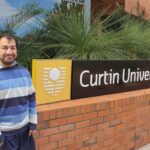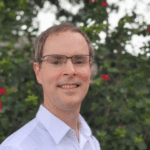Curtin’s planetary scientists will contribute to remote operations on the Moon and Mars as part of an exciting new Australian space consortium.
Perth is set to become a global centre for remote operations in space, using local expertise that will take robotics and remote operations from the mine site to the Moon.
Launched on 17 February, the Australian Remote Operations for Space and Earth (AROSE) consortium comprises Curtin, the State Government of Western Australia and The University of Western Australia, with industry partners Woodside, Fugro and Nova Systems.
“We can leverage industry expertise in Australia to take remote operations into space, and deliver solutions that benefit the Australia–NASA Moon-to-Mars program,” says planetary geologist Professor Phil Bland, from Curtin’s Space Science and Technology Centre (SSTC).
“AROSE brings together the best of Australian industry with the most advanced technology and leading WA scientists, on a project that has got deliverables in the economy and in research.”
The Curtin team will contribute its unique ‘Binar’ technology, used to build ‘CubeSats’ – small, lightweight satellites with low launch costs and minimal fuel requirements.
“Each element of a CubeSat is built around a 10-centimetre cube. Ours is an advanced, highly integrated version where all the systems are compacted into a single multi-layer circuit board,” Professor Bland explains.
“It means more room for all the other systems you want the satellite to do. We can put a big camera on it, we can map the surface of the Earth for different types of rocks or we can send the satellite to other planets.”
Curtin will be engineering all the systems required to operate the satellites, including power, computer, steering and communications systems. These tasks provide hands-on experience for Curtin PhD researchers and students.
“Being able to build our own spacecraft here in Perth is really exciting – the SSTC is an amazing team.
“And through AROSE, we can make that small-satellite capability available to industry for any relevant project – whether it be testing remote operations protocols in space, or inspecting mine sites,” Professor Bland says.
Curtin University’s Vice-Chancellor Professor Deborah Terry says Curtin is proud to be joining a project that harnesses the strengths of both research and industry to drive innovation in the space and technology sectors.
“Curtin’s University’s Space Science and Technology Centre is home to the largest planetary research group in the Southern Hemisphere and will be a valuable asset and contributor to the AROSE project,” Professor Terry says.
“We are delighted to be able to offer Curtin’s world-class facilities, technology and expertise to this exciting collaboration that has the potential to not only solve some of the world’s most complex problems, but to inspire the next generation.”
Under Curtin’s Binar Spacecraft Program, ‘Binar’ being the Nyungar word for fireball, the SSTC also aims to develop a lunar orbiter that will deliver data for NASA’s Artemis program, which is expected to land astronauts on the Moon within four years.
“NASA’s goal is to go to the Moon to stay, which means you can’t take all your fuel and oxygen with you. It’s about finding your resources there – such as from ice and iron ore,” says Professor Bland.
“That’s where Australian expertise in remote operations comes in. My dream is that in 10 years we are the default service provider for remote operations facilities, such as operating NASA robots on the Moon to harvest ice for fuel.
“In addition to what we can do for AROSE, we can give a leg-up to new space start-ups coming to Perth. If they want to fly a payload, they won’t have to build their own spacecraft.”

Remote operations opportunities from AROSE will improve the state’s economy by $196 million per year and support more than 1,500 jobs in the next five years according to economic modelling.
Western Australia Science, Innovation and ICT Minister Dave Kelly says AROSE will also enhance the productivity and safety of existing industries through advanced remote asset management, and research and development in robotics.
“This is about harnessing a once in a lifetime opportunity to create a new industry and new jobs out of our fantastic resource sector’s advanced capabilities in remote robotics and automation,” Minister Kelly says.



